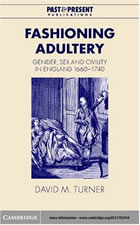Author's response
| Book: | Fashioning Adultery. Gender, Sex and Civility in England, 1660–1740David M. TurnerCambridge University Press, Cambridge, 2002; ISBN 0521792444, pp. 236 |
| Reviewer: | Seth DenboUniversity of Sheffield |
I am grateful to Seth Denbo for his thoughtful review of my book. It is a very positive assessment of my work that leaves me little to respond to. I am pleased that he has found so much to praise and that he feels that my close attention to the language of marital infidelity succeeds in enriching our understanding of the meanings of extra-marital sex and the ways in which class increasingly bore on perceptions of sexual immorality in the late seventeenth and early eighteenth centuries.
At several points Denbo draws attention to the approach of my study, which organises its chapters around different genres in which marital infidelity was discussed. This approach was chosen for a number of reasons. Firstly, responding to the linguistic turn in historical studies, I wanted to produce a cultural history of adultery that examined the ways in which the form of different texts influenced and shaped the ways in which infidelity was represented. Secondly, I was fascinated by the explosion of print culture in the later seventeenth and early eighteenth centuries, which resulted in a proliferation of genres in which adultery was discussed and wanted to explore how this changed perceptions of sexual immorality. By focussing on the ways in which representations of adultery developed within different types of writing I hoped not simply to describe but to demonstrate how this proliferation of genres changed the meanings of infidelity. My aim was to provide a multi-layered perspective on cultural change, by comparing how representations of adultery developed across genres. Denbo highlights what I think is a key advantage of this approach, in that it thickens description and moves away from a cultural history based on a single type of source. By showing how these sources are linked together by recourse to a common language of sexual misconduct, I was able to show the impact of sharpening social differentiation and concepts of civility and politeness on perceptions of sexual immorality.
However, towards the end of his review, Denbo seems worried that this approach seems to preclude the possibility of allowing texts and interrelated cultural discourses to interact with each other, and that it makes it difficult for my work to reach a wider potential. In response, I would like to say that in each chapter I have tried to draw out different aspects of infidelity in this period, together with their broader social and cultural implications, along with charting shifting textual representations. In the course of examining representations of adultery in murder pamphlets, for instance, I discuss perceptions of violent responses to infidelity and the complicated issue of provocation. The chapter on matrimonial litigation in the church courts reads depositions against the grain in order to speculate on the question of why men and women might have had affairs in this period - something that has received surprisingly little historical attention previously. Moreover, my study of bawdy humour shows how, during its late seventeenth-century heyday, cuckold comedy did not simply comment on patriarchal domestic relations, but also provided a potent means of satirising the contemporary social scene. My book does not claim to be comprehensive and there are some aspects, such as the role of adultery in political propaganda and issues around the transmission of property through inheritance that, though by no means neglected, receive less coverage. To have studied these issues in depth would have moved me away from the original aims and scope of my project. Besides, they have been given some attention already by historians of this period, whereas some of the key themes that interest me, such as linking changes in politeness to sexual mores, have not.
I would also disagree that my approach somehow stops texts and cultural discourses from interrelating with each other. Individual chapters can be read as case studies, but I feel that my sources do interact with each other across chapters. Bawdy comedy (chapter 3) clearly inverts the values set out in conduct literature (chapter 2) and it is interesting to compare how the law produces a variety of means of judging adultery in different judicial settings (chapters 5 and 6). The study of language that begins the book is intended to tie together the disparate sources and indicate lines of enquiry pursued in subsequent chapters.
In writing my book I hoped to indicate that studying sexual mores has, as Denbo puts it, 'the potential to illuminate the hidden depths of a culture whose basic assumptions can at times seem utterly alien'. This is the rationale for studying the history of sexuality, and it is what makes it such an exciting and fruitful field in which to work. I hope my book will stimulate historical debate and lead to further study of this fascinating topic.
June 2003

